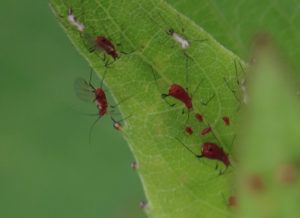The Birds and the Bees and the…Aphids?
 We all know (generally) how baby animals are made: the male and female encounter one another, some mode of intercourse is engaged (enthusiastic, coerced, or otherwise), and after some period of time the female gives birth or lays eggs to begin the next generation.
We all know (generally) how baby animals are made: the male and female encounter one another, some mode of intercourse is engaged (enthusiastic, coerced, or otherwise), and after some period of time the female gives birth or lays eggs to begin the next generation.
Aphids–those abundant garden pests–have a rather more complex series of strategies. Who knew? And their abundance is in part due to their unique method of reproduction.
Aphids will generally overwinter as eggs. In the spring, the eggs hatch into a generation that is entirely female. These females (fundatrices) will, without having mated, give birth to other females that are essentially genetic clones of herself. And she gives birth to live babies, not eggs! No need to faff about with finding a mate, cooking some babies and laying eggs–female aphids can be already developing their own babies before being born themselves.
The first generation of females born are wingless. Individuals in later generations may or may not have wings; since the wingless individuals are not able to move from plant to plant easily the winged versions help to disperse and carry on the population as the original host plants become crowded.
As the summer passes into fall, the females begin to produce both male and female offspring. The males again are nearly genetic clones of their mother but missing a single chromosome, which flips the switch and produces a male clone instead of a female. This generation will (finally) mate and these females will lay the eggs that will survive the winter and begin the cycle again the following year.
Originally published in Sycamore Greenway Friends.


